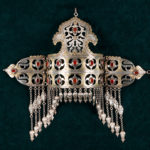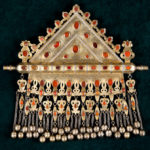Elaborate silver, gilt jewelry, carpets, and textiles from the Turkomen tribes of Iran, Afghanistan, and Turkmenistan are the focus of the exhibit, Splendid Treasures of the Turkomen Tribes from Central Asia. It features more than fifty objects hand-crafted by the semi-nomadic Turkomen peoples, jewelry made of precious metals and semi-precious stones, and woven rugs and colorful textiles created in the late-nineteenth to mid-twentieth centuries.
Originally from Mongolia, the Turkomen are one of the major ethnic groups of Central Asia. Traditionally, they were semi-nomadic, migrating with the seasons to find pasture and fertile land. This lifestyle meant wealth had to be easily portable. Jewelry and textiles represented a form of wealth and were used for special festivities as well as daily adornment. The designs are drawn from Turkomen mythological interpretations of the natural world, as well as Islamic art, and are an important window into the world of tribal identity.
Textiles played a diverse role in Turkomen culture as well, serving not only for decorative and utilitarian functions in the form of clothing, pillows, floor coverings, and doors, but also for ceremonial and religious purposes. Turkomen dress was frequently noted for its rich, decorative qualities—clothing was often decorated with exquisite embroidery and made of hand-woven silk. When combined with the lavish use of jewelry, it created a striking effect.
Weavings were not only light and transportable, but were made from readily available wool from their own flocks of sheep. Later, these rugs and weavings became an important source of income as they became popular in Europe and Russia. Today, Turkomen jewelry and textiles continue to be celebrated for their quality, distinctive colors, and decorative patterns.
The exhibit’s jewelry was collected by Stephen Van C. Wilberding when he was a senior advisor to the Saudi Arabia Monetary Agency and donated to the Ringling Museum of Art. The McClung Museum has complemented the jewelry selection with textiles and weavings from Knoxville collector Judy Stewart and the Persian Galleries.
- Articulated Headpiece with Pendants (Ildirgic), Western Yomud Tribe, 1880–1920, silver, gold, carnelian, Wilberding Collection of Turkomen Tribal Jewelry, Ringling Museum of Art. This beautiful headpiece displays the characteristics of skilled of Turkomen silversmithing in its exquisite metalworking.
- Amulet Breastplate (Tumar), silver, gold, carnelian, Wilberding Collection of Turkomen Tribal Jewelry, Ringling Museum of Art.
UT’s exhibition was organized by the John and Mable Ringling Museum of Art, the State Art Museum of Florida, and Florida State University, in Sarasota, Fla. Associate Curator: Catherine Shteynberg
Splendid Treasures is made possible with support from UT’s Ready for the World Initiative, BarberMcMurry Architects, and the Aletha and Clayton Brodine Museum Fund.


